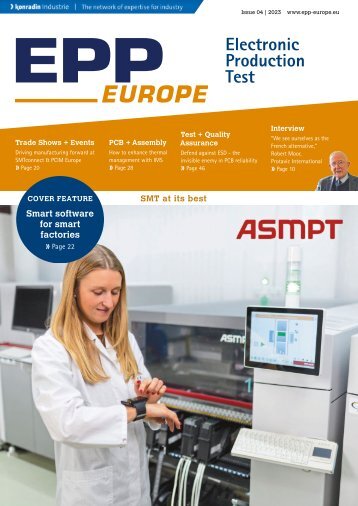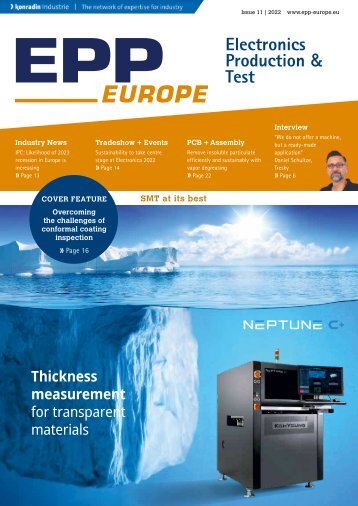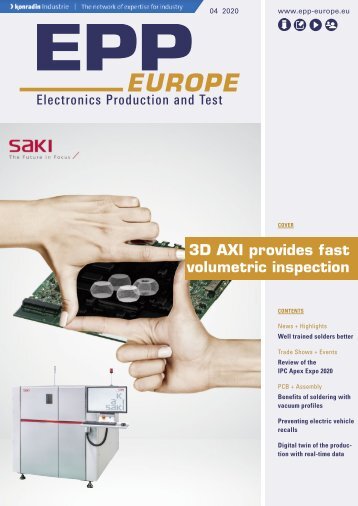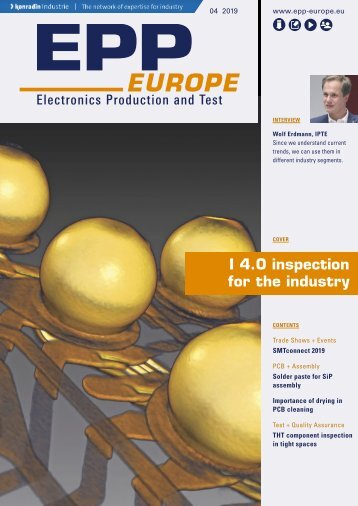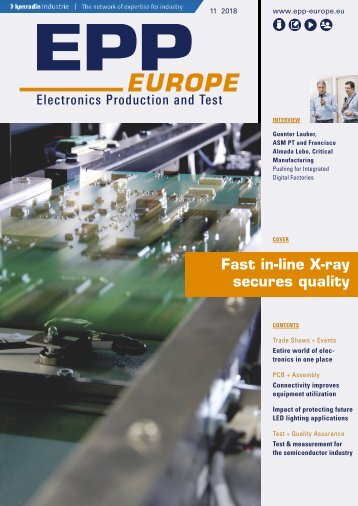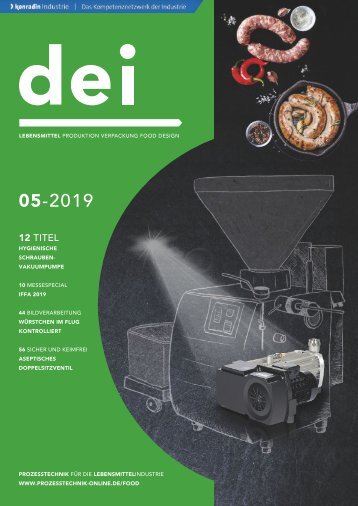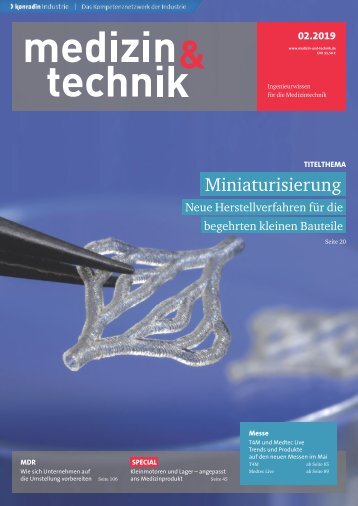EPP Europe P2.2022
- Text
- Measurement
- Assembly
- Semiconductor
- Soldering
- Solutions
- Manufacturing
- Components
- Electronic
- Inspection
- Electronics
» TEST & QUALITY
» TEST & QUALITY ASSURANCE Automatic x-ray inspection (AXI) What are AXI systems capable of in 2022? In modern SMT production lines, AXI systems are mainly used for fully-automatic inspection of hidden solder joints that are not visible to an AOI system. For anything that requires close to one hundred percent optical inspection coverage, there is no getting around the use of both an AOI and an AXI device, as the authors of this article explain. So what exactly can modern AXI systems do? And why are they so important? Source: Göpel electronic In modern SMT production lines, AXI systems are used for the fully-automatic inspection of hidden solder joints not visible to an AOI system An AXI system is absolutely comparable to an AOI system – only the images are not as beautifully colourful,” jokes Andreas Türk, product manager AXI at Jena-based testing and inspections solutions provider Göpel Electronic. The company’s most recent AXI systems offer a wide array of features including fast-scanning image acquisition; inspection programme creation; industry 4.0 integration; and, thanks to the digital predictive maintenance concept, self-monitoring. In addition, the systems are all connected within one network. If an anomaly is found, data from the SPI, AOI and AXI systems is displayed together on the verification station. This helps operators track down the source of the fault (see image overleaf). Image acquisition tech The newest AXI systems are able not only to scan assemblies vertically (socalled 2D) or at an oblique angle (socalled 2.5D) in order to inspect solder joints, but also using a technique called 3D x-ray inspection. This technology allows for the inspection of solder joints in several layers and, as such, offers the hig- hest degree of defect detection and coverage. In part, it is the combination of all three image acquisition technologies that provides the best inspection result. Since 3D technology generates a synthetic 3D image using several obliquely-captured images (in a process known as image reconstruction), the image acquisition time is longer than when using conventional 2D or 2.5D technologies. 3D systems with flat-panel detectors struggle here because the time for stop-and-go movement of the axes is significantly longer than the actual time required for image acquisition. 40 EPP Europe » 11 | 2022
Source: Göpel electronic AXI text programme creationis similar to that of AOI. After the CAD data import, the image data sets required for tuning are recorded once. Further test programme creation can then be carried out completely offline "As a rule of thumb, when using eight oblique images for a 3D image field, you can expect an image acquisition time of about 3–5 seconds,“ explains Türk. Depending on the image field size and the number of 3D image fields required, this can add up, and the acquisition time for a high-runner product is too long. Göpel has come up with a solution for this (see image below). Cycle time reduction The company‘s AXI system X Line 3D relies on line detectors to keep image acquisition time low. Several detectors take 2D, 2.5D and 3D X-ray images in parallel, and in motion. This concept makes it possible to inspect larger areas of the PCB or complete multiple panels in 3D. In addition to the image acquisition time, the time for PCB handling, image processing and optional MES export are included in the total cycle time. For this reason, X Line 3D systems have a three-chamber principle. There are three PCBs in the system at one time in inline mode. Once image acquisition of the board has been completed, it is immediately moved out of the beam path into another chamber. This is where post-processing takes place. This reduces both total cycle time and radiation exposure for the components (see top two images overleaf). Intelligent PCB handling Over the years, the systems have also become smarter in terms of PCB handling. The PCBs that are inspected by AXI systems vary in size, weight and friction coefficient, among other things. In the past, these differences were not taken into account and PCBs were always transported at the same belt speed. This can take up valuable cycle time. For this reason, the X Line 3D system belt transportation system independently learns the optimal belt speed by means of intelliFLOW. After an automated teach-in process, the machine stores the optimal transport parameters specific to the inspection programme. Usage-based maintenance System downtime for maintenance work is often problematic. At Göpel, systems use a service & maintenance app which creates usage-based maintenance plans in advance and monitors the machine. Self-diagnosis using predictive and preventive maintenance management ensures stable machine conditions and repeatable, consistent performance. Every key component of the machine is monitored and a detailed maintenance summary is generated. A preventive maintenance plan reduces machine downtime and therefore costs. On a practical level, work no longer has to be carried out according to scheduled maintenance cycles. Instead, usage-related values (such as kilometres travelled by the axes; pneumatic strokes, and X-ray source radiation hours) are monitored. These values are given a warning and service threshold. If the warning threshold is exceeded, preventive maintenance can be initiated. The app enables operators to simultaneously monitor several machines. This makes maintenance easier to plan and reduces downtime. Source: Göpel electronic On the left, a 2D X-ray image of a BGA. Capacitors on the bottom side reduce the inspection coverage. In the 3D slice image (right), the capacitors are no longer visible. The BGA itself can be evaluated in several layers Matthias Müller is Public Relations Manager at Göpel electronic Andreas Türk is Product Manager AXI at Göpel electronic EPP Europe » 11 | 2022 41
- Page 1 and 2: Issue 11 | 2022 www.epp-europe.eu E
- Page 3 and 4: » EDITORIAL » EDITORIAL Dear read
- Page 5 and 6: Vapor degreasing: almost all semico
- Page 7 and 8: duce machines in high quantities wi
- Page 9 and 10: NEWS & HIGHLIGHTS « 3. Digital sup
- Page 11 and 12: Boost for U.S. semiconductor indust
- Page 13 and 14: NEWS & HIGHLIGHTS « QUALITY PIEKTR
- Page 15 and 16: TRADE SHOWS & EVENTS « ified the g
- Page 17 and 18: AT A GLANCE In this article, Koh Yo
- Page 19 and 20: The LIFT measurement principle. The
- Page 21 and 22: MK Versuchsanlagen PCB maker acquir
- Page 23 and 24: Bild: Microcare Particulate contami
- Page 25 and 26: Rework technologies PDR launches in
- Page 27 and 28: Versatile format The biggest differ
- Page 29 and 30: Product Updates « PCB & ASSEMBLY I
- Page 31 and 32: PCB & ASSEMBLY « Source: ED&A Sour
- Page 33 and 34: Adhesives manufacturer strengthens
- Page 35 and 36: Dual-curing adhesive for medical de
- Page 37 and 38: Selective soldering systems Sasinno
- Page 39: New online offering for 4K digital
- Page 43 and 44: Zusammenfassung Röntgensysteme mü
- Page 45 and 46: RF performance characterization Tes
- Page 47 and 48: G3VM-21MT reference design board te
- Page 49 and 50: The range of T-circuit MOSFET relay
- Page 51 and 52: MEETINGS & COURSES Jan. 21-26 CONFE
Inappropriate
Loading...
Mail this publication
Loading...
Embed
Loading...


